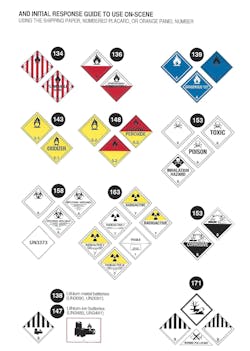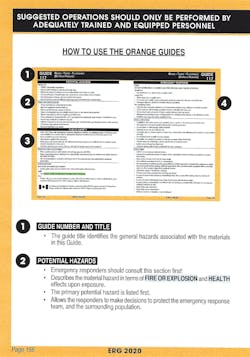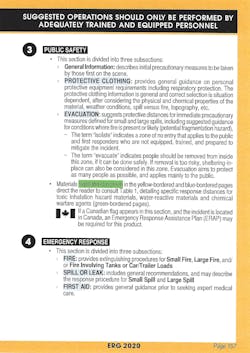On Aug. 7, 2020, following a several-month delay that was caused by the pandemic, the U.S. Department of Transportation (DOT) announced the publication of the 2020 Emergency Response Guidebook (ERG), and there are numerous notable changes (see “Evolution of the ERG” sidebar.) DOT has published the ERG every three or four years since the 1970s. According to DOT, the ERG is “a guidebook that is intended for use by first responders during the initial phase of a transportation incident involving dangerous goods/hazardous materials.” Further, the ERG is the only reference book that many responders at incidents will have access to. Not only is information that’s in the book good for transportation incidents, but, in my opinion, it will work for any hazmat incident. For example, isolation and downwind protection distances that are found in the green pages of the ERG can be used effectively by hazmat team members during any stage of an incident.
It is important that responders thoroughly are familiar with the ERG and are trained on its use. More than 1.5 million free copies have been provided to first responders nationwide by DOT through contacts in each state.
DOT emphasizes that first responders should resist rushing in. Hazmat incidents don’t occur often in many of the jurisdictions. They are technical in nature and can be extremely dangerous to first responders. It is important that first responders exercise competencies that are outlined by Occupational Safety and Health Administration Standard 1910.120, NFPA 472: Standard for Competence for Responders to Hazardous Materials/Weapons of Mass Destruction Incidents and NFPA 473: Standard for Competencies for EMS Personnel Responding to Hazardous Materials/Weapons of Mass Destruction Incidents. These standards are designed to keep responders safe at the scene of a hazmat incident while dictating their limitations in terms of training and equipment. The ERG can assist responders to take the proper precautions and actions on scene of a hazmat incident.Things I’d like changed
There are a couple of things about placarding on which I have disagreed with DOT for many years. I lobbied without success to make changes that I believed were important to emergency responders.
Anhydrous ammonia is a common hazardous material that has killed emergency responders and citizens. Everywhere else in the world, it’s considered a poison, which is toxic by inhalation, and corrosive. DOT considers anhydrous ammonia a nonflammable compressed gas, despite the material’s flammability under certain conditions. It isn’t listed as flammable, because it doesn’t meet DOT’s definition of a flammable gas.
Cryogenic liquids are gases that are liquefied to allow for more product to be shipped and stored in smaller containers. (It’s pure economics.) DOT doesn’t have a hazard class for cryogenics. The temperatures of these liquids start at -150 degrees F and run to -452 degrees F. Contact with the human body can cause frostbite and solidification of body parts. Contact with other materials can solidify them and cause them to shatter like glass. There is no protective equipment that will protect responders against the cold dangers. I would like a placard for “Extreme Cold” for these materials. This concept isn’t new: Molten materials carry an additional placard of “HOT.” What is the difference?How to get the ERG
Free copies of the ERG are provided by DOT to all fire, police, EMS and other emergency response organizations through a selected agency in each state. State contacts are listed on the 2020 ERG website at phmsa.dot.gov/hazmat/erg/emergency-response-guidebook-erg, as is access to a .pdf copy of the 2020 ERG. The Pipeline and Hazardous Materials Safety Administration partnered with the National Library of Medicine to provide a free smartphone version of the 2020 ERG for emergency responders. Copies also are available online for a fee from private companies.
I developed a training course for the 2016 ERG that’s available in PowerPoint CD-ROM. Included are an instructor guide and student manual, a list of state ERG contacts, a list of private-sector sources for the ERG, a course certificate template, a final exam and an electronic version of the ERG. For information about the ERG training course, email [email protected] or visit hazardousmaterialspage.com.Evolution of the ERG
The field of hazardous materials is a relatively new subject for emergency responders. The U.S. Department of Transportation (DOT) developed the first version of a responder guidebook in 1977. It was called “Hazardous Materials: Emergency Action Guide.” It was 87 pages long and contained information on 43 chemicals. During the 1980s, DOT created the first version of the ERG that utilized today’s familiar format. It contained 66 Orange Guides, a placard chart, and numerical and alphabetical sections—although they weren’t color-coded, as they were in later versions. There have been 12 editions of the ERG to date: 1980, 1984, 1987, 1990, 1993, 1996, 2000, 2004, 2008, 2012, 2016 and 2020. For comparison, the 2020 version of the ERG contains 392 pages and lists hundreds of chemicals.
A number of changes were made to the 2020 ERG to make it more useful to emergency response personnel.
- “Intermodal Freight Container” was added to the Road Trailer Identification Chart
- A gasoline placard was added to the Table of Markings under Orange Guide 128
- A new placard was added under Class 9 on the Table of Markings for lithium-metal batteries (Orange Guide 138) and lithium-ion batteries (Orange Guide 147)
- In the “Pipeline Transportation” section, a new “Hazardous Liquid and Highly Volatile Liquid Pipelines” heading appears
- Chemical, biological and explosive materials were added to the front pages of the yellow pages, replacing four-digit guide numbers
- “Call 911” was added before “call emergency response telephone number on shipping paper” on all Orange Guides under “Public Safety”
- “Call 911 or emergency medical service” was moved to the top of the list under “First Aid” in the Orange Guides
- Instructions for use of the Orange Guides were added to the beginning of the section
- An “Immediate precautionary measure” heading was added to some of the Orange Guides’ “Evacuation” sections
- Orange Guide 121 was left blank, because there are no chemicals that refer to this guide
- Orange Guide 123 had “And/Or Corrosive” removed from heading
- Orange Guide 125 had “And/Or Corrosive” added to the “Gases–Toxic” heading
- Orange Guide 167 was left blank, because there are no materials that refer to this guide
- The “BLEVE” section had “and Heat Induced Tear” added to its heading, with more information and a better format
ERG Sections
The ERG is divided into sections that are identified by the color of the pages.
White pages
White pages are informational in nature. They include information and charts to assist responders in using the ERG and to assist in product identification. Information that’s in the white pages includes:
- “How to Use the Guidebook” flow chart
- DOT Hazard Classification System
- Table of Markings, Labels and Placards
- Rail Car Identification Chart
- Globally Harmonized System of Classification and Labeling of Chemicals (GHS)
- Hazard Identification Numbers Displayed on Some Intermodal Containers
- Pipeline Transportation
- BLEVE and Heat Induced Tear information
- Criminal or Terrorist Use of Chemical, Biological and Radiological Agents
- Improvised Explosive Device Safe Stand-Off Distance chart
- 24-Hour Emergency Response Telephone Numbers
Yellow pages
Yellow pages provide hazardous material identification using the four-digit identification number that’s found in the center of a placard, in an orange rectangle on a container or both. Once the number is located in the yellow pages, the name of the material is identified, as is a three-digit Guide Number. Placards that have a four-digit number only are found on bulk quantities of hazardous materials in large containers.
Blue pages
Hazardous materials may be found in many types of containers and packaging. In some cases, only a name of a material is known. When a name of a material is known, it can be found alphabetically in the blue pages of the ERG. Once again, when the name is located in the blue pages, you will be directed to a three-digit number that’s located in the Orange Guides where additional information can be found about the hazardous material.
Orange Guides
Orange Guides are broken down into specific subject headings that are based on a particular hazard(s). Each page has three subheads: “Potential Hazards,” “Public Safety” and “Emergency Response.” Under “Potential Hazards” there are two sections: “Health” and “Fire or Explosion.” The order in which these two sections are listed isn’t consistent throughout the Orange Guide. This is because the section that’s listed first is considered to be the most severe hazard for materials that are referred to on an individual numerical guide page. “Public Safety” contains three subjects: general information, “Protective Clothing” and “Evacuation.” “Evacuation” provides information to first responders that concern spills and fires. Distances are provided for initial isolation and downwind protection. These distances in the Orange Guides and in the green pages are determined by computer modeling and historical incident information. In some cases, these might change from one edition of an ERG to another, both upward and downward, depending on new information that’s determined by more-accurate computer modeling and new incident data. “Emergency Response” provides information on “Fire,” “Spill or Leak” and “First Aid.”
Green pages
Green pages primarily are for hazardous materials that are a toxic inhalation hazard and the distances for adequate vapor protection for both responders and the public. Listings in this section are by four-digit number. Protective action distances are provided for small spills and large spills; initial isolation distances depend on the size of a spill and whether the spill occurred during the day or night. Inhalation hazard vapors can travel farther at night than during the day, because wind conditions generally are calmer at night. Additional information in the green pages involves hazardous materials that produce inhalation hazard vapors when they come into contact with water.
Green highlights
Materials that are highlighted in green in the yellow and blue pages are inhalation hazard materials that are listed in the green pages of the ERG. Details of the materials’ initial isolation and downwind protection distances are located in the green pages. When a material is highlighted, don’t go to the Orange Guides, but rather go to the green pages for information.
Materials that have a “P”
Materials that are listed in the yellow and blue pages that have a “P” next to the three-digit Orange Guide number are capable of undergoing polymerization. This is a spontaneous expansion type of chemical reaction. If it occurs within a container, the container might come apart explosively. Once the polymerization reaction starts, it will continue until it is finished, regardless of what responders do.
Materials that are capable of undergoing polymerization are referred to as monomers. Monomers must have a chemical added to them in transportation and storage to prevent the polymerization from occurring until the monomers are ready for it in a chemical process. This chemical is called an inhibitor. In a chemical process vessel, the inhibitor is removed, and a catalyst is added, which controls the rate of the chemical reaction.
Placards and railcar charts
Placards that have a four-digit identification number and product names aren’t available always. For this reason, charts are provided in the ERG for placards and labels from each DOT hazard class that lists a three-digit Orange Guide that can be used for the material. If no placards or labels are visible in an incident that involves a tanker truck or railcar of hazardous materials, there is a chart that provides a three-digit Orange Guide based on the type of container. Responders should realize that this information is very generic and should be used as a last resort.
About the Author

Robert Burke
Robert Burke, who is a hazardous materials and fire protection consultant and who served as a Firehouse contributing editor, is a Certified Fire Protection Specialist (CFSP), Fire Inspector II, Fire Inspector III, Fire Investigator and Hazardous Materials Specialist. He has served on state and county hazmat teams. Burke is the author of the textbooks "Hazardous Materials Chemistry for Emergency Responders," "Counter-Terrorism for Emergency Responders," "Fire Protection: Systems and Response," "Hazmat Teams Across America" and "Hazmatology: The Science of Hazardous Materials."



